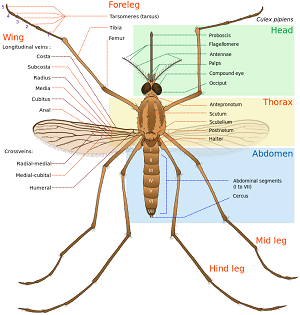About mosquitoes in Montenegro
Third research year
At the same period sampling by larval dipping, resting catch, resting catch using Žbun TiN MNE and human bait was conducted at 21 sampling site.
At 06th and 12th July EVS-CO2 traps were operating at localities Mataguži and Zlatica in Podgorica by Dr Maria Zgomba and Dr Igor Pajović.
From August 04th to 11th human bite sampling technique was conducted at Lustica peninsula in Tivat (Krtole, Radovići and Krašići) by Dr Romeo Bellini, Dr Dušan Petrić and Dr Igor Pajović.
Oviposition traps were positioned at 70 sites in total.
BothEVS-CO2 and Gravid traps were positioned within the backyards of the houses and in nature, at the places protected from the strong wind, operating from the afternoon to the next day morning.
In total 473 male and female mosquito specimens belonging to 15 species were sampled.
Mosquito species sampled (underlined – species/groups not registered in previous two years):
1. Anopheles maculipennis s.l. (malaria vector)*
2. An. saccharovi (malaria vector)*
3. Aedes geniculatus
4. Aedes caspius (vector of Rift Valley Virus and Dirofilaria immitis and D. repens nematodes)*
5. Aedes albopictus (vector of Chikungunya and Dengue viruses and Dirofilaria immitis and D. repens nematodes)*
6. Aedes pulchritarsis
7. Aedes vexans (vector of Tahyna virus)*
8. Aedes punctor
9. Aedes communis
10. Aedes cinereus
11. Culex pipiens (vector of West Nile, Sindbis and Rift Valley viruses and Dirofilaria immitis and D. repens nematodes)*
12. Culex hortensis
13. Culiseta annulata
14. Culiseta longiareolata
15. Coquillettidia buxtoni
16. Culicoides sp.** (Blue Tongue Virus vector)
17. Simulidae ***
* In the brackets following the names of identified species only major pathogens of man (species 1, 2, 4, 7 and 11) and/or animals (4, 5, 11, and 16) are given.
** Genus Culicoides belongs to family Ceratopogonidae, not Culicidae (mosquitoes) but we decided to register they presence being the vectors of deadly blue tongue disease of sheep.
*** Black flies (family Simuliidae) could be the major molestants of domestic animals and humans. During the field study in northern Montenegro, 17 species of blackflies had been sampled, 15 of them recorded for the first time in Montenegro.
Second research year
During 2015. traps were positioned within the backyards of the houses and in nature, at the places protected from the strong wind, operating from the afternoon to the next day morning. NS2 traps were baited exclusively by CO2. BG traps were baited by the lure for the invasive container mosquitoes and CO2. In total 657 male and female mosquito specimens belonging to 12 species; 692 Culicoides spp.; 17 Phlebotominae and 3 Simuliidae were sampled. Determination of Culicoides spp. and Phlebotominae to species level will be performed by VectorNet project experts, Dr Thomas Belenghien and Dr Bulent Alten.

Mosquito species (linked species/groups not registered in 1st research year):
1. Anopheles maculipennis s.l. (malaria vector)*
2. An. plumbeus (malaria vector)*
3. An. saccharovi (malaria vector)*
4. Ochlerotatus (Dahliana) geniculatus
5. Ochlerotatus caspius (vector of Rift Valley Virus and Dirofilaria immitis and D. repens nematodes)
6. Ochlerotatus (Acertomyia) zammitti
8. Aedes (Stegomyia) albopicta (vector of Chikungunya and Dengue viruses and Dirofilaria immitis and D. repens nematodes)
9. Culex pipiens (vector of West Nile, Sindbis and Rift Valley Viruses and Dirofilaria immitis and D. repens nematodes)
14. Culicoides sp.*** (Blue Tongue Virus vector)
* In the brackets following the names of identified species only major pathogens of man (species 1, 2, 3, 5, 8, 9, 13) and/or animals (5, 8, 9, 13 and 14) are given.
** Subfamily Phlebotominae, sand flies, are important vectors of cutaneous and visceral laismaniasis in neighbouring Albania
*** Genus Culicoides belongs to family Ceratopogonidae, not Culicidae (mosquitoes) but we decided to register they presence being the vectors of deadly blue tongue disease of sheep.
First research year
Identifications of adult mosquitoes collected from the different places in Montenegro during the season 2014., sampled by BG Sentinel traps or human bite sampling. Samples were identified according to morphological characters by the dichotomous key Becker et al. (2014).
Traps were positioned most frequently within the backyards of the houses at the places protected from the strong wind, operating from the afternoon to the next day morning. Traps were baited by the lure for the invasive container mosquitoes and in some occasions with mixture of water, sugar and brewer’s yeast that produced CO2.
On man, all mosquitoes landing on the front body parts were sampled during 5-15 minutes period by the battery powered aspirator.
By all sampling methods 2012 male and female mosquito specimens belonging to 7 species were sampled:
- Anopheles maculipennis s.l. (vector of malaria)
- Aedimorphus [Aedes] vexans (vector of Rift Valley Virus and Celovo Virus)
- Dahliana [Ochlerotatus] echinus
- Ochlerotatus caspius (vector of Rift Valley Virus and nematodes Dirofilaria immitis and D. repens)
- Ochlerotatus sticticus
- Stegomyia [Aedes] albopicta (vector of Chicungunia Virus, Dengue Virus and nematodes Dirofilaria immitis and D. repens)
- Culex modestus (vector of West Nile Virus and nematodes Dirofilaria immitis and D. repens)
- Culex pipiens (vector of West Nile Virus, Sindbis virus, Rift Valley Virus and nematodes Dirofilaria immitis and D. repens)
- Culicoides sp. (vector of Blue Thong Virus)
Becker, N., Petric, D., Zgomba, M., Boase, C., Madon, M., Dahl, C., Kaiser, A., Mosquitoes and Their Control, Springer, 2nd ed. 2010,
 |
 |
 |
 |
Download selected pages - mosquito morphology

